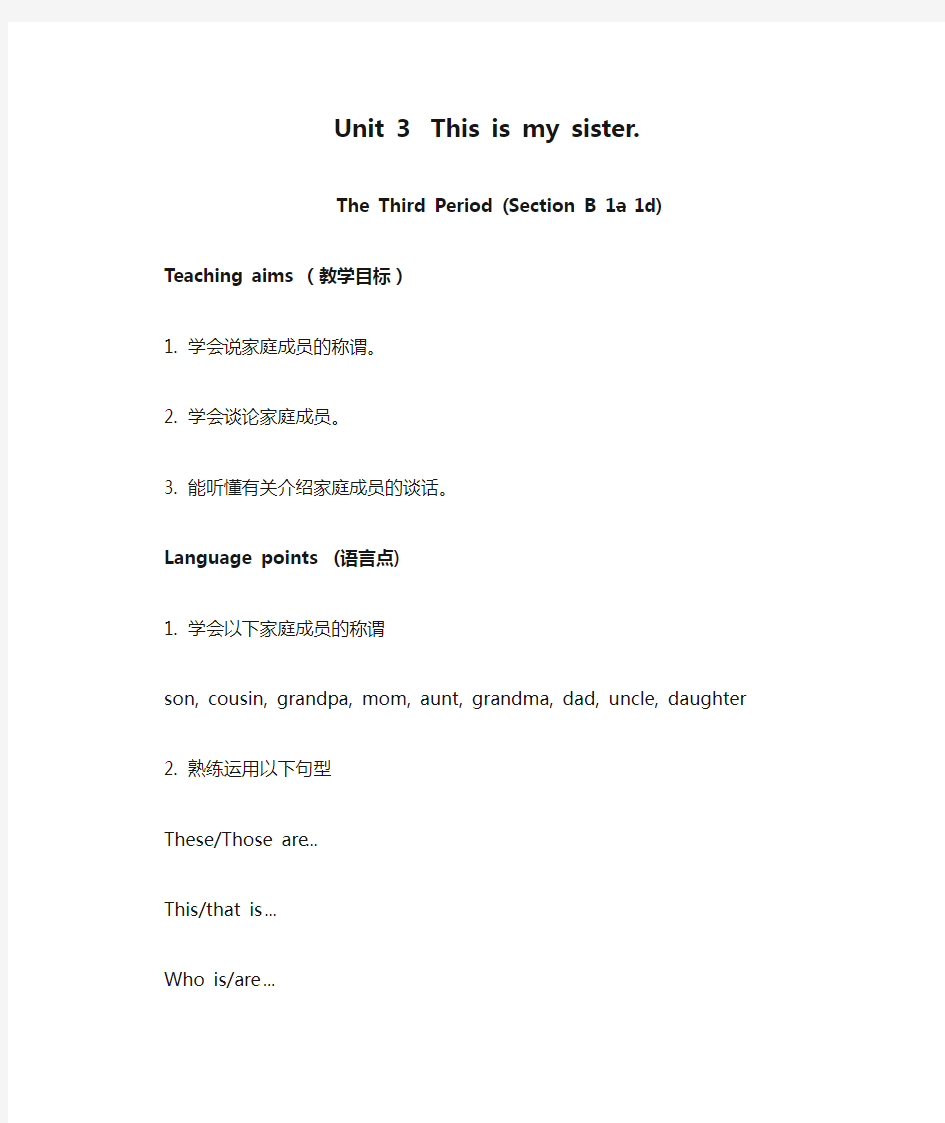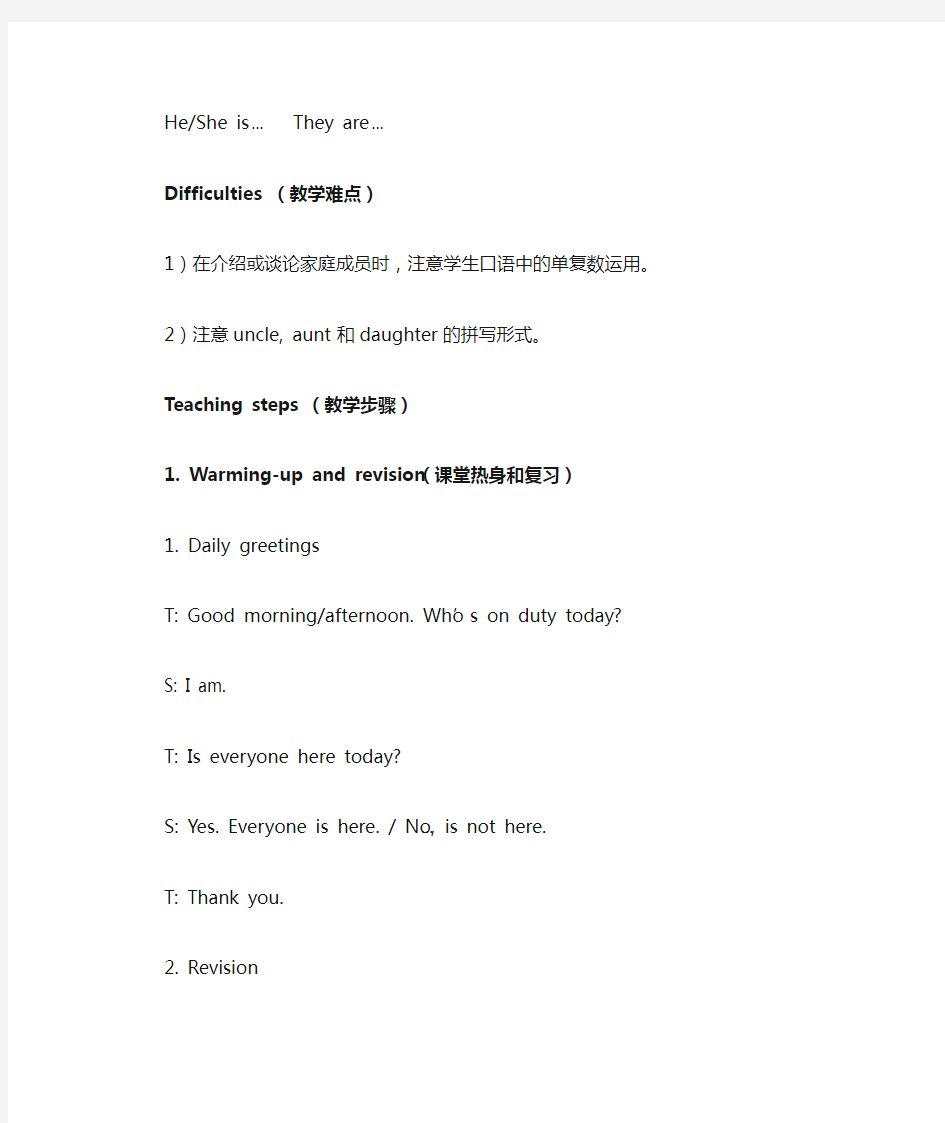Unit 3 This is my sister.Section B 1a-1d教学设计及反思


Unit 3 This is my sister.
The Third Period (Section B 1a – 1d)
Teaching aims (教学目标)
1. 学会说家庭成员的称谓。
2. 学会谈论家庭成员。
3. 能听懂有关介绍家庭成员的谈话。
Language points (语言点)
1. 学会以下家庭成员的称谓
son, cousin, grandpa, mom, aunt, grandma, dad, uncle, daughter
2. 熟练运用以下句型
These/Those are…
This/that is …
Who is/are …
He/She is …They are …
Difficulties (教学难点)
1)在介绍或谈论家庭成员时,注意学生口语中的单复数运用。
2)注意uncle, aunt 和daughter的拼写形式。
Teaching steps (教学步骤)
1. Warming-up and revision(课堂热身和复习)
1. Daily greetings
T: Good morning/afternoon. Who’s on duty today?
S: I am.
T: Is everyone here today?
S: Yes. Everyone is here. / No, … is not here.
T: Thank you.
2. Revision
T: Have you brought your family photos? Now please take out your family photos and introduce your family members.
A: Hello …Look, this is my family photo.
B: Oh. Who’s he( she)?
A: He (She) is my …
B: Who are they?
A: They are my …
B: Oh! What a happy
family!
【教学设计说明】本环节一方面是为了让学生尽快进入英语课堂氛围,另一方面,也检查了学生的课后作业,了解他们是否带上照片并向同伴介绍了照片上的人物。
2. Presentation (呈现新知识)
1)通过多媒体展示一张全家福<家有儿女>,介绍上面的人物,呈现生词dad 和mom。
2)照片中人物做自我介绍,呈现生词son和daughter。
e.g. These are my parents. I am their son.
Those are my parents. I’m their daughter.
3)通过出示图片做猜测游戏呈现uncle 和aunt
e.g. He is not my father. He is my father’s brother. He is my uncle.
She is not my mother. She’s my mother’s sister. She is my aunt.
4) 通过展示叔叔一家的图片,引出cousin。
e.g. Here is a photo of a family. Look at the boy and the girl in this photo. They are not my brother and sister. The boy is my uncle’s son. He is my cousin. The girl is my uncle’s daughter. She is my cousin, too. They are my cousins.
【教学设计说明】教师事先准备自己或明星的全家福,引起学生的学习兴趣,在一步步的猜测介绍中引出生词,及时板书。在这一环节中,老师可以通过学生已知的词汇引导他们说出新词汇。如:教师提示mother’s sister,看有没有学生说出aunt。这样,既活跃了课堂氛围,也使学生对人物之间的关系有了更深的印象。在口语中,教师有意识地使用Here is …句型,为下一课的Here are …句型的学习做一个铺垫。
3. Work on 1a (完成1a)
1) T: In my family, my grandpa is the oldest. (板书oldest并用body language表述) Who is the oldest in your family?
S: My grandpa, too.
T: Every family has a family tree. Can you finish the family tree in 1a?
S: Yes.
While the students are working, the teacher moves around to see what the students write.
2) Check the answers and ask students to read aloud the words.
3) T: Look at the family tree. My grandpa and grandma have a son and a daughter. One is my dad, the other is my aunt. My dad and mom also have a son and a daughter. I am their daughter. My brother is their son. I am my brother’s sister. My aunt and uncle only has one daughter. She’s my cousin.
【教学设计说明】教师先引导学生完成家谱,然后再以第一人称的方式介绍家庭成员之间的关系。帮助学生进一步巩固词汇,理清家庭成员之间的称谓。
4. Work on 1b (完成1b)
1)T: Let’s listen to the recording in 1b. I’ll play the recording once. You only check the words you hear. (If the students can’t hear clearly, play the recording once again.)
2) Check the answers and ask some individuals to read the words aloud.
【教学设计说明】由于学生对生词已有了较为深刻的印象,因此,让他们勾出所听到的词汇并不困难。抽单个学生朗读,是为了检查学生是否能正确发音。
5. Work on 1c (完成1c)
1)T: Look at the two pictures in 1c. Who are they in the first picture? Can you guess?
S: They are Grandpa, Grandma, Mum, Dad, Uncle …(只要学生能说出人物的称谓就加以鼓励)
T: Well done. Can you guess who they are in Picture 2?
S: They are Grandma, Mum, Dad and a boy.
T: Quite well. One of the pictures is Jiang Tao’s, and the other one is Tom’s. Do you know which one is Jiang Tao’s and which one is Tom’s?
S: No.
T: Now let’s listen to the recording and find out the answers.
2)Play the recording once again for the students to listen and find out the answers.
3) Check the answers and play the recording for the students to listen and repeat.
【教学设计说明】从图片入手,教师引着学生先谈论,讲明要求再听,不但降低了听的难度,让学生都有成功的喜悦,同时也培养了学生专心听的习惯。
6. Work on 1d (完成1d)
1)Teacher draws a picture of his/her family and friends on the blackboard and introduces the people.
2)T: Now you can draw a picture of your family and friends.
3) Ask one or two students to show their pictures and tell the class who they are.
T: Tim, Can you show me your picture? Who are they? Can you tell me?
S: This is my … and These are my …
4) T: Now you can tell your partner about your picture.
【教学设计说明】在让学生动手画之前教师要给以示范,让学生知道从哪儿入手。抽一、两个学生介绍自己的照片,也是给其他同学做出示范,让他们知道怎样介绍图片。如果时间太紧,就让学生把这一任务作为课后家庭作业。
7. 拓展阅读
1,listen and fill in the blanks.
2, listen and answer the questions.
3, listen and judge.
8. 综合说。介绍自己的姓名,年龄,电话号码和家庭成员。
9. Summery ( 小结)
1)T: Next,please answer my questions.
a. How many family words do you know?
b. Can you make a family tree about your family?
c. What problems do you still have?
10. Homework (课后作业)
Oral: 1)朗读并背诵本堂课所学的生词。
2)口头介绍自己的全家福及朋友的全家福。
Written: 1)抄写本堂所学的生词各三遍。
2)在作业本上写出句子介绍自己的全家福。
【教学设计说明】给学生布置书面表达不仅是检查他们能否掌握本单元的基本句型,同时也是培养学生观察图片,养成能说会写的好习惯。
板书Unit 3 This is my sister.
The Third Period (Section B 1a – 1d)
cousin, uncle, aunt, son, daughter
These/Those are…
This/that is …
Who is/are …
He/She is …They are …
二次上课反思
我上的是第二单元,this is my sister. Section B的第一课时。重点词汇是cousin, uncle, aunt, son, daughter。句型是These/Those are… This/that is …Who is/are … He/She is …
They are …学生通过学习掌握不错。第一次上课介绍家人是用我来描述的,学生学得机械,第二次上课老师们建议用《家有儿女》的图片来介绍,学生们就是更感兴趣,学得更好。
第一次上课学生们没带齐家庭照,第二次上课几乎每个学生都准备了,没有的也画了一幅。学生们更有话说。
还有就是因为初一知识较简单,第一次上课拓展听读只有两篇,剩余时间比较多,老师们提议多设计一篇,拓展学生的阅读量,并增加了任务。上课时间分配更好。
通过二次上课,课堂更流畅,讲课更有条理,也注意到了板书的整洁。重难点知识更容易突破了。
